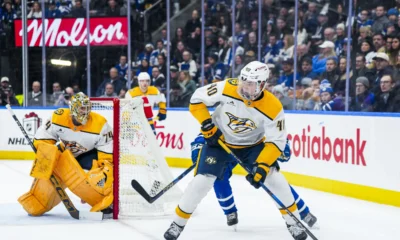There comes a time in any sport that a major change must be made in order to protect players. In football, the goal post was moved to the back of the end zone and a five-yard bubble was created between the sidelines and field of play. In baseball, there’s a warning track before the outfield wall. Basketball evolved its hoop to a padded, L-shaped frame. All were done to increase player safety.
Hockey is an ever-changing sport. It’s a fast-paced game enjoyed by people of all ages. In the last few decades, the game has change dramatically as players are bigger and faster at the pro level. As the game has increasingly become faster, there haven’t been many drastic changes for player safety besides making helmets and visors mandatory in the NHL. More and more cases are beginning to open concerning concussions with former NHLers, but what about the game before players reach that level? What is being done to help teach youth hockey players about their own safety? Enter the Look-Up Line.
The Look-Up Line is basically a warning track for hockey, and it’s coming to the Ford Ice Center in Antioch, Tennessee. It’s been a topic of some controversy as some in the hockey world are adamantly against change, but the Look-Up Line is an attempt at a solution to help curb injuries at any level of hockey. Thomas E. Smith is the co-founder of the Thomas E. Smith Foundation, which developed the Look-Up Line. Smith suffered two paralyzing injuries while playing Junior A hockey. After sustaining those injuries, he made it his mission to make a difference.
“With any cause, it’s very typical to have a knee jerk reaction whether someone is diagnosed with cancer or paralysis, you want to help better that,” said Smith. “You don’t want to see anyone going through what a loved one has gone through. With our foundation, we knew that we wanted to try to find a cure for paralysis.”
The injury began to eat at Smith as he began to think of his future and how he could change other lives by preventing injury.
“I saw a lot of my friends getting married and having children,” said Smith. “I think to myself, ‘Am I ever going to be able to teach my children how to skate?’ There were so many unanswered questions. To alleviate that, I made it my mission to make the game of hockey better.”
Smith is extremely passionate about making a change in the game, but knows that it has to come from the top before anything can happen:
“The executives and lawmakers in hockey have not changed the game. I understand the heritage and that’s what makes it beautiful, but where the actual speed of the game has gone and where coaches and players have progressed in the game, we just stood there and scratched our heads and said, ‘There’s got to be a way to make this game safer without affecting the speed, intensity, heritage or adding more rules to the game.” That’s where my passion really comes from, where I’ve suffered from two, separate paralyzing accidents in the greatest game in the world. This year would have been my senior year in college.”
As everyone knows, it takes time to study how to increase player safety. Smith and his colleagues tried out multiple methods, but it took over a year to develop the Look-Up Line. They started out by adding padding behind the boards, but that resulted in the puck stopping dead upon impact. It took watching another sport to get the idea he needed all along.
“I got a bit discouraged on what I had been working on for the past 14 months,” said Smith. “I was watching a Red Sox game and saw a ball player slow down once he reached the warning track without looking down. So I decided to look at what all other sports had done to allow players to allow players to make bodily adjustments before making contact with solid objects.”
This is where he saw the changes that football, baseball and basketball had made in their games. What was important to his team though, was increasing player safety without changing how the game itself was played without adding more rules or equipment. They decided to look into behavioral sciences to find a difference solution:
“When you want someone to create a behavior, you either do one of three things. You speak to them and tell them to do something, which in hockey you can’t do that during a game and we know most paralyzing accidents happen during a game, over 80%. With the blade of the skate, you can’t do anything to the ice without changing the game to make it so a player can feel a difference. The only thing that hockey has done is visual queuing. You have blue and red lines, goal lines, circles, everything. To me, it was crazy that hockey, being the fastest, most intense sport of them all, didn’t have a warning before hitting the board.”
Now that the idea was there, how would it be installed? Smith had to find a way to place a warning track on the ice without changing the change.
“The next challenge was making it applicable for each age bracket and making it universal. So I contacted Timmy Roberts (Buffalo Sabres ’87) and Stefan Brannare (Pittsburgh Penguins ’97) to get help on transferring it to the ice to make it make sense to hockey players. We did a couple of speed tests and came to a consensus that without overlapping the lower hash marks in an NHL-sized rink, the 40-inch marker is the most appropriate. It sounds like a lot, but when you actually see it and play in a game, it really isn’t that far out. We went into the behavioral science of things and looked for the universal color for caution that the eye picks up and the mind remembers that all people can identify too. It was orange. With 151C safety orange, when your eye picks it up, your mind immediately associates it with caution.”
Next, it had to be tested. It’s certainly a major change to the way the ice looks to the players.
“When we filmed it on camera, it looked great,” said Smith. “We had a couple NHL players skate on it and they said it didn’t interfere with the way they saw the puck. So we tried it. We put it down in 2013 for the first time and here we are today. It’s growing at a rate that we want it to and hope it continues.”
Speaking of growth, the sheets of ice at Ford Ice Center will have it when it officially opens in September. Nashville and the Predators organization are on the leading edge of changing the face of hockey for the better.
“It’s been awesome,” said Smith. “Danny Butler has been fantastic in terms of communication, enthusiasm and overall willingness to help the cause and better the game of hockey with us. It’s been a pleasure working with them and those in Nashville.”
By showing commitment to player safety, those that come to Nashville to play will see how dedicated the community is to putting the safety of the player above everything else.
“Why I’m so thankful for what the folks in Nashville have done is that they’re willing to be leaders by example,” said Smith. “Nashville is the first organization that came to us and said, ‘We’re going to do this and we believe in it. We care about protecting our players from the Predators all the way down to the youth level.’ I think that really speaks volumes about who’s running the Predators organization”
The Look-Up Line is continuing to spread across the country and it has even been approved to be installed at NCAA rinks.
“We have over 225 rinks, including Nashville and the state of Tennessee, in 21 states that are committed to installing the Look-Up Line before October 1st,” said Smith. “We’re moving, but we know it can do better. Now that it is permissible by the NCAA, over 20 Division III colleges and eight Division I colleges will install it.”
Craig MacDonald, Hockey Director at Ford Ice Center even noted how it can help in officiating for a cleaner game.
“The Look-Up Line can be a great point of reference for referees in making calls,” said MacDonald. “It’ll only help make the game safer as they can more accurately make boarding calls.”
As the game continues to evolve, it’s important to recognize that changes must be made:
“The player has outgrown the architectural make up of a hockey rink. The numbers don’t lie. Players are having to retire because of catastrophic injury more than ever before. I feel that it is the job and the duty for the lawmaker and the executives of these leagues to do something about it. The Look-Up Line is such an inexpensive way, without affecting the game, to better the player and have the best longevity in the game. If you pick your head up when you go into the boards and hit with your face as opposed to the crown of your head, you are 99.99% less likely to break your neck and suffer a concussion. If made part of the hockey curriculum, you’re less likely to injure yourself and break your neck. It’s so important to teach young players to do this. When you get older, that’s when the body mass can actually break the neck. We don’t paralyzing injuries in five and six year olds. It usually begins in 10 year olds. That’s why I say it’s a no-brainer for the NHL. When you go into the boards with your head down, it’s not the initial contact that breaks the neck, it’s the body mass that follows through and crushes the cervical area.”
Smith understands that while this is a solution for now, there are always other ways to improve the game. What he wants people to understand is that the Look-Up Line is just the beginning and that the powers that be should always do everything in their power to improve player safety.
“We’re not saying it’s going to be the end-all to be-all solutions, because there are still going to be accidents,” said Smith. “We believe that it is going to save lives and allow the game to progress. We don’t want a reactive approach. We don’t want something to happen, a player to break their neck in a rink, at any level, and then decide to install the Look-Up Line. It’s not going to get that person out of the wheelchair.”
As with any change to any sport, there are some that disagree with the Look-Up Line because it’s change. What is most important is to educate those that may disagree with it to help them understand why the change is necessary.
“The biggest thing to me is that if you disagree with the Look-Up Line, make me understand why you’re not doing it,” said Smith. “Make me understand where we’re wrong and why you shouldn’t spend $500 on the betterment of the players to potentially save lives. I often compare this to two things, if you don’t smoke cigarettes, does that mean you won’t get cancer? No, but you reduce the risk of getting cancer. By having the Look-Up Line down, you reduce the risk of the player of suffering catastrophic injury. It’s a fact.”
Hockey is a game we all love. Of course we all know that safety is important to the player, but should the question of “at what cost” even be an option? The sport is built on tradition, but the tradition is what the players and team carry with them. Traditions change. Players change, but the game itself will always be beloved.
“The tradition of the game is what makes it beautiful,” said Smith. “What is not good is players having to retire due to catastrophic injury.”
Strong words for a strong case.
To learn more about Thomas E. Smith and the Look-Up Line visit justcureparalysis.org.
















